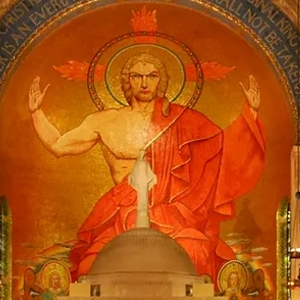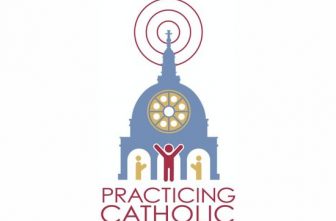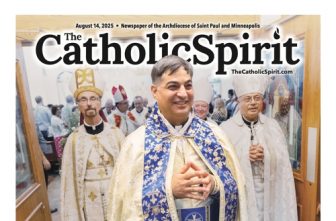
Anyone who has been to the National Shrine of the Immaculate Conception in Washington, D.C., cannot help but notice the very large mosaic above the apse of “Christ in Majesty” sitting in judgment.
Love it or hate it, this sacred image speaks to all gazing upon it an uncomfortable truth about Jesus: Jesus is not simply our friend, akin to our version of “Minnesota nice,” in which everyone readily believes in a God who is patient, kind, smiling and forgiving. Ending there would be a half-truth. The divine person of Jesus would be incomplete if we didn’t also accept that he is the spirit of truth.
“Jesus Christ is the same yesterday, today, and forever” (Heb 13:8). Christ’s first coming proclaims the God of mercy, whereas his second coming ushers in the God of justice. And though it’s true in Scripture, we struggle accepting that God cannot be love without truth, nor truth without love. An analogy I heard can help: If truth is the root or foundation of a plant, and love is its fruit or flower, then mercy is the stem that holds those two together.
So, what are we all to make of Jesus’ seemingly contradictory and confusing words in Sunday’s Gospel: “Do you think that I have come to establish peace on the earth? No, I tell you, but rather division” (Lk 12:51).
The depth of Christ’s peace is not of this world. Worldly or military peace is a superficial or forced getting along, like tolerating one’s parents, siblings and relatives without the fire of love and forgiveness, unity and peace defining God’s plan for family. Growing up in a family of 10, I found there were always ample opportunities for love and forgiveness.
What kind of fire is Jesus setting upon Earth and what kind of fire does he wish were already blazing?
Fire has qualities that can help or harm us. Fire produces light, heat, destruction, purification, etc. And Christ’s purifying fire is moving the hearts of people today to ask three existential questions: Why am I here? Where am I going? How do I get there?
This past Easter, a significant number of dioceses experienced a major uptick in millennials entering the Church or coming back to the faith of their baptism, giving many young people a reason for hope; a genuine sense of belonging, meaning, purpose; and a peace that God indeed has a plan for their lives.
Combined with the witnesses of soon-to-be saints like, Blessed Pier Giorgio Frassati and Blessed Carlo Acutis, God is lighting a fire in the minds and hearts of seekers who cannot help but believe there must be more to life than the instant gratification and the unholy human trinity of me, myself and I.
It was the late, great St. John Paul II who often said: The future of the Church and society flows through marriage and family. As marriage and family go, so go the Church and the rest of society.
Let’s all begin by reclaiming the Lord’s Day (Sunday) for ourselves and for our families. Such a tiny, but vital spark of God’s love, mercy and truth will bring a measure of peace and unity to our families and to our Church, to ignite a fire in us that Jesus wishes were already blazing.
It’s said that a picture is worth a thousand words. The image of “Christ in Majesty” heralds an urgent and powerful message that every human life and family matters to God. And by the look on Jesus’ face, his body language, he commands you and me to be part of the solution, and not part of the problem.
Father Eilen is pastor of St. Mary of the Lake and moderator of Frassati Catholic Academy, both in White Bear Lake.
Sunday, Aug. 17
Twentieth Sunday in Ordinary Time




